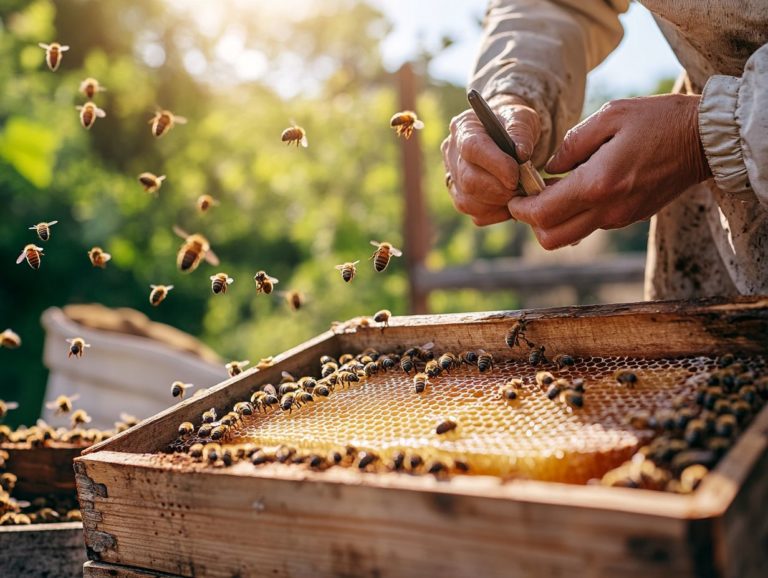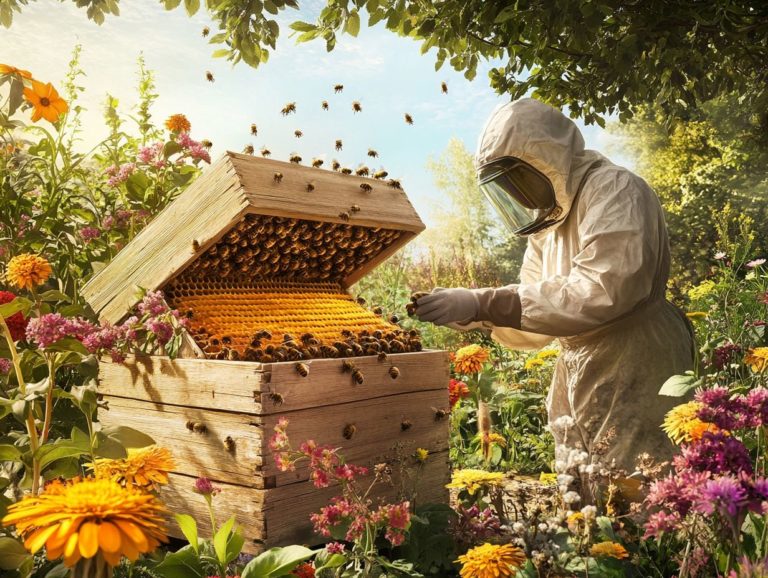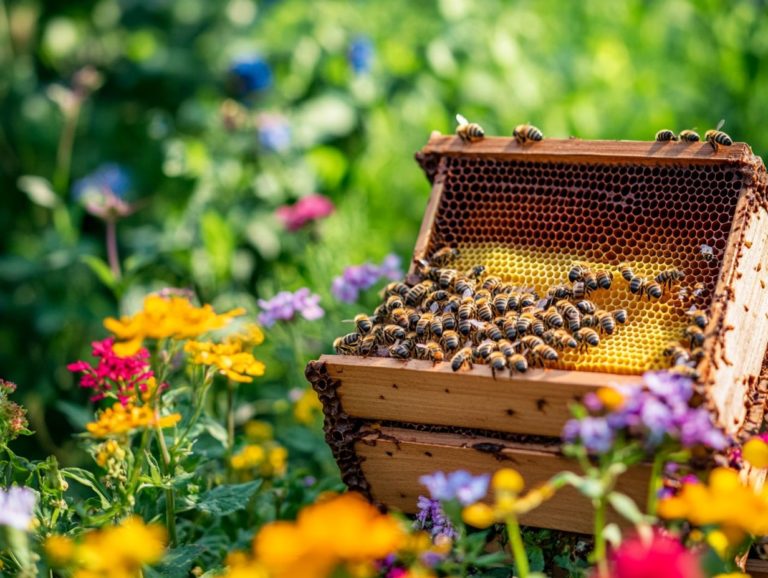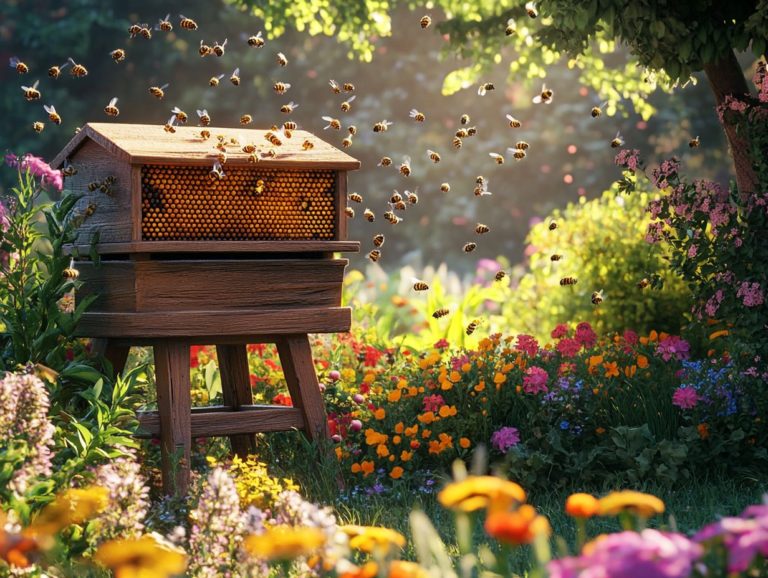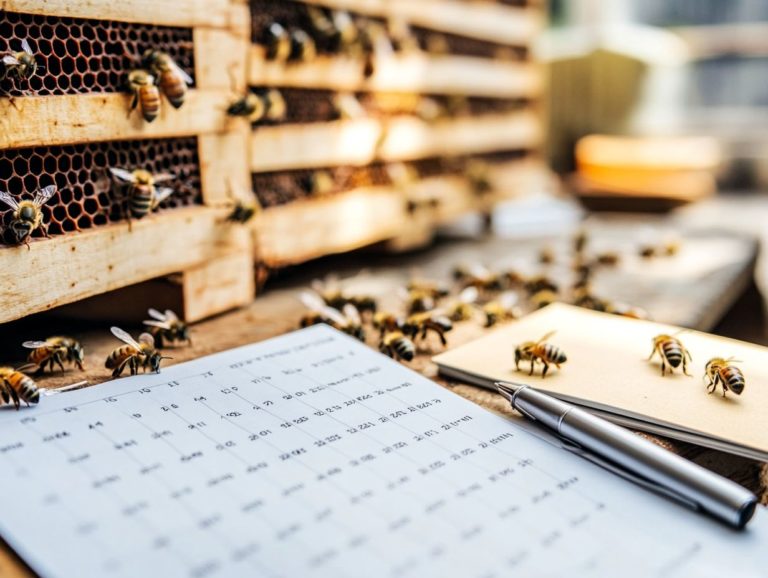How to Set Goals for Hive Management
Effective hive management, such as implementing a comprehensive apiary action plan, is vital for you as a beekeeper striving to enhance productivity and maintain healthy colonies.
By setting clear goals, you create a roadmap that provides direction and allows you to measure your progress and success effectively. This article delves into the benefits of goal setting in hive management, highlighting key factors to consider, such as compliance with neighbors and the various types of goals you can establish. Ready to take your beekeeping to the next level? Let’s jump right in!
Contents
- Key Takeaways:
- Why Goal Setting is Important for Hive Management
- Factors to Consider When Setting Goals for Hive Management
- Types of Goals for Hive Management
- 2. Maintenance Goals and Beekeeping Management
- 3. Expansion Goals and Apiary Expansion
- How to Set Effective Goals for Hive Management and Beekeeping Practices
- Monitoring and Adjusting Goals for Hive Management
- Frequently Asked Questions
- What are the benefits of setting hive management goals?
- How do I determine the right goals for my hive management and Apiary Action Plan?
- How many goals should I set for my hive management and Apiary Action Plan?
- Should I involve my team or other beekeepers in setting goals for hive management and Apiary Action Plan?
- How often should I review and adjust my goals for hive management and Apiary Action Plan?
- What should I do if I am not meeting my goals for hive management and Apiary Action Plan?
Key Takeaways:
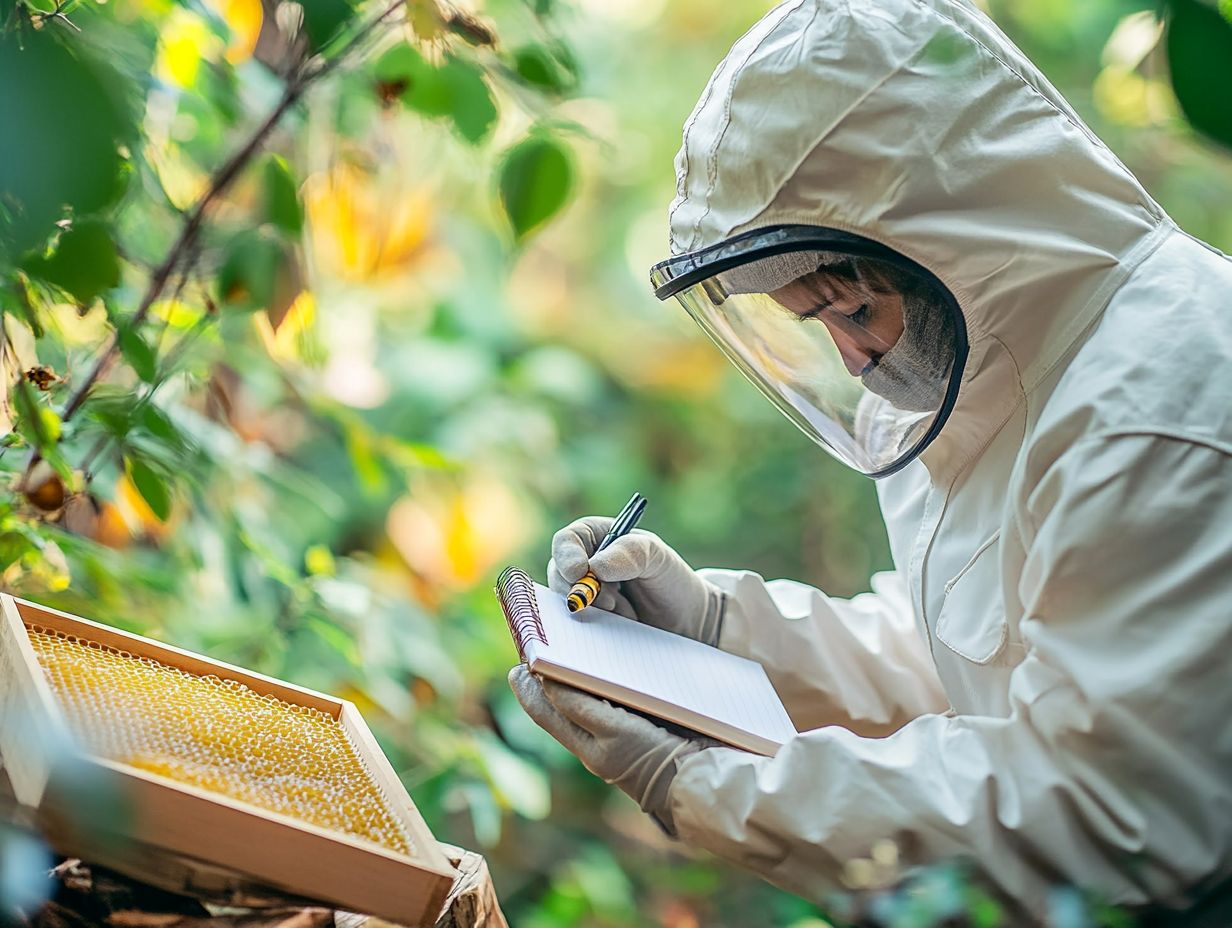
- Setting goals for hive management is crucial for the overall success and health of your bee colonies.
- When setting goals, consider factors such as timeframe, resources, experience, and hive health.
- Effective goals should be specific, measurable, realistic, and have a set deadline. Regular monitoring and adjustments are also important for achieving goals, which can facilitate apiary expansion.
Why Goal Setting is Important for Hive Management
Goal setting is crucial in managing your beekeeping endeavors, as it offers a structured pathway to achieve a comprehensive vision for your apiary. It empowers you to implement strategic practices like queen rearing, hive manipulation, pest control, and dearth management strategies, ensuring that every season from summer management to honey production is optimized for the health of your colonies.
By establishing clear objectives, you can effectively navigate the ecological impacts of your actions while fostering community involvement and enhancing your efforts to expand your apiary. Keeping diligent records will support your performance tracking and help you reach your goals, making goal setting an essential foundation for sustainable beekeeping and agricultural sustainability.
What Are the Benefits of Setting Goals for Hive Management?
Setting goals for hive management brings a wealth of benefits that can significantly enhance your beekeeping practices, resulting in improved honey production and healthier bee colonies. By establishing clear objectives, you can focus on vital pest control measures, like managing Varroa Mites and Small Hive Beetles, while ensuring that hive inspections are carried out regularly to assess the strength and health of your colonies.
Effective record-keeping allows you to track your progress toward these goals, empowering you to make informed decisions that contribute to overall management and business management.
Having specific targets enables you to pinpoint the strengths and weaknesses of each hive. This attention fosters better bee health and ensures that your colonies experience less stress and greater productivity.
Regular inspections are crucial; they help you catch potential issues early on and provide valuable insights into the behaviors and trends that impact honey production. By meticulously documenting your findings, you create a reference that can guide your future decisions, ultimately leading to a sustainable and thriving beekeeping operation while adhering to environmental impacts.
Factors to Consider When Setting Goals for Hive Management
When creating an apiary action plan, there are several critical factors to ensure effective goal setting. Foremost among these factors is the health of your hives, which requires regular assessments of colony strength and conditions. You also need to evaluate the availability of essential resources for beekeeping, including the necessary equipment and materials.
The location of your apiary significantly influences the feasibility of certain goals, such as honey production or pest control, and is essential for compliance with neighbors. Understanding the broader context of beekeeping practices is crucial for effective goal setting, encompassing sustainability and local regulations.
1. Timeframe
Establishing a clear timeframe for your goals in hive management is essential, as it dictates how you will navigate the seasonal rhythms of beekeeping practices, all while aligning with the natural cycles that impact honey production and bee health. Ensuring that your apiary infrastructure can support these goals is equally important. For instance, you should consider dearth management strategies during late summer and early fall when nectar sources are limited. This awareness will influence how you set both your short-term and long-term goals for your apiaries.
By recognizing these seasonal shifts, you can adjust your plans accordingly, aiming for specific milestones such as achieving peak honey production during the vibrant spring bloom. For example, prioritizing the installation of additional supers in May can help you maximize yield before the summer dearth sets in.
Being adaptable is key; it allows you to respond proactively to unexpected weather changes or pest outbreaks, ensuring that your goals remain attainable even in the face of fluctuating environmental conditions. This approach requires constant monitoring and a willingness to pivot your strategies to maintain the health and productivity of your hives throughout the year.
2. Resources
The resources at your disposal for beekeeping are essential to the success of your goal-setting process. They encompass everything from beekeeping supplies and hive design to automation technology and apiary infrastructure. By evaluating both the quality and quantity of these resources, you can establish realistic and achievable goals that enhance colony health and boost honey production.
For instance, a well-designed hive with optimal ventilation and insulation can have a significant impact on the health and productivity of your bee colony, giving you the power to aim for higher honey yields.
Incorporating automation technology, such as sensors to monitor hive conditions, can streamline your management processes and reduce labor. This ultimately aligns your efforts with specific goals, such as increasing the number of productive hives.
Access to quality tools and educational resources can further empower you to troubleshoot issues effectively, ensuring you stay on track with your objectives throughout the beekeeping season. For instance, protective equipment is crucial for safe hive inspections and management.
3. Beekeeping Experience
Your experience as a beekeeper plays a crucial role in shaping your goals for hive management, influencing your understanding of effective practices and your capacity to implement innovative techniques. If you have more experience, you might delve into advanced strategies such as organic practices or pest control management, and you could also find value in seeking mentorship, which enhances community involvement and fosters knowledge sharing.
As a seasoned beekeeper, you may leverage your established connections within the community to collaborate on practical projects, facilitate workshops, and share essential resources, including best practices for honey harvest. This network not only creates a supportive environment but also enriches your learning journey, making it easier to adopt new technologies and methods, such as automation technology.
By engaging with other beekeepers, whether they are novices or experts, you help cultivate a culture of continuous learning where questions are exchanged freely and innovative ideas flourish. Ultimately, this collective effort strengthens the beekeeping community as a whole, ensuring that everyone can thrive and adapt to the ever-evolving challenges of hive management.
4. Hive Health and Population
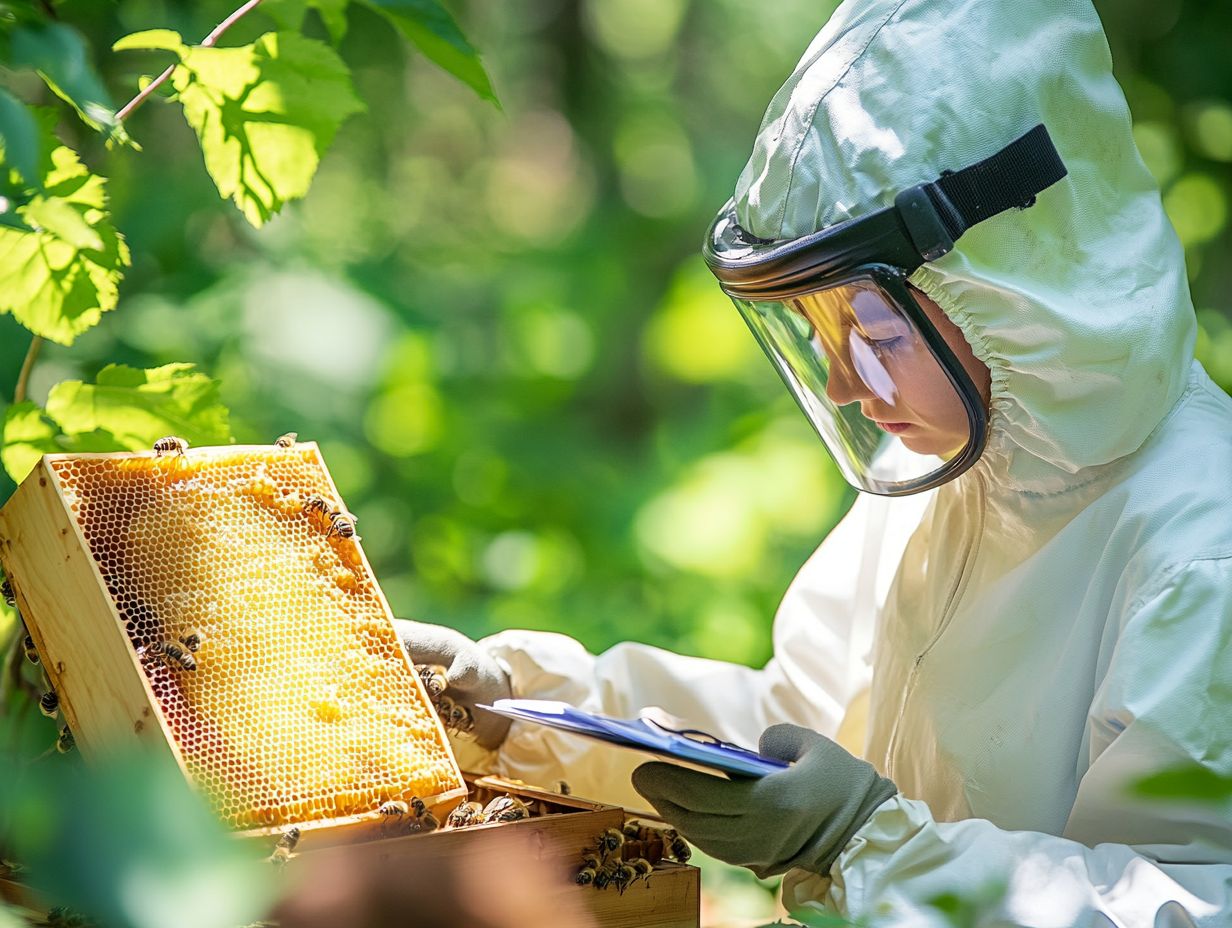
Assessing hive health and population is crucial for you when it comes to setting effective goals in beekeeping management. It directly impacts colony strength and your bee health management practices. Regular checks for whether the queen bee is present and healthy and monitoring for pests like Varroa Mites and Small Hive Beetles are essential steps you should take to ensure the longevity and productivity of your hives. These factors ultimately shape the goals you set for honey production and the overall health of your apiary.
Actively monitoring your hive can spot problems early and keep your bees thriving! Implementing methods such as regular inspection schedules allows you to confirm the presence of the queen and assess the vigor of the workforce and brood patterns. This offers valuable insights into the colony’s overall vitality. Regular queen-right checks are essential in maintaining your hives’ productivity.
Incorporating a combined approach to managing pests into your routine will help mitigate the risks associated with pests, ensuring your hive remains resilient. These efforts help maintain colony strength and align with your long-term goals for honey production, ecological awareness, and environmental sustainability, highlighting the interconnectedness of hive health and effective goal setting in your beekeeping journey.
Types of Goals for Hive Management
Establishing a range of goals for hive management can greatly elevate the effectiveness and sustainability of your beekeeping practices. Incorporating innovative beekeeping techniques can further enhance your strategy.
Production goals are important as they focus on maximizing honey output while ensuring that your bee populations remain healthy and thriving.
Maintenance goals play a crucial role as well. They focus on effective hive management through consistent inspections and diligent pest control, including the management of Small Hive Beetles and Varroa Destructor.
Meanwhile, expansion goals allow you to gaze into the future. They prepare you for apiary growth and foster increased community involvement in local honey production, leveraging resources for beekeeping and innovative beekeeping techniques.
1. Production Goals and Hive Manipulation
Your production goals in hive management should focus on enhancing honey production while ensuring the overall health of your bee colonies. This involves effective hive manipulation and seasonal management strategies, including queen rearing and honey harvest.
To achieve these goals, it’s essential to maximize the use of drawn comb and ensure that your hives are well-equipped to take full advantage of peak nectar flows.
By employing strategic hive manipulation techniques, you can create optimal living conditions for your bees, leading to stronger and more productive colonies. This ensures effective summer management and dearth management. Seasonal management is vital; by understanding the natural cycles of nectar availability, you can make timely decisions, such as adding supers during heavy nectar flows.
Careful monitoring of hive health indicators allows you to address potential issues proactively. This prevents them from escalating and maintains a thriving environment for your bees. These dedicated efforts will boost your honey yield and sustain the overall vitality of your hive, setting the stage for long-term success and sustainable beekeeping practices.
Start setting your goals now and watch your beekeeping flourish!
2. Maintenance Goals and Beekeeping Management
Your maintenance goals should focus on the ongoing health and stability of your bee colonies. This means conducting regular hive inspections and implementing effective pest control measures. By keeping detailed records of hive conditions, you can identify trends and make informed decisions that enhance the longevity and productivity of your apiary. Incorporating beekeeping management practices is essential for achieving these goals.
These maintenance objectives are crucial not just for maximizing honey production but also for preventing potential outbreaks of diseases or infestations that can harm your bees. Regular inspections empower you to monitor the overall well-being of the colony, allowing you to spot signs of pests like Varroa mites or diseases such as American foulbrood. This includes checks to ensure that the queen bee is healthy and laying eggs properly along with preventive measures to counteract potential threats.
By meticulously documenting these inspections including observations about the queen’s laying patterns, overall bee behavior, and environmental conditions you position yourself to adopt preventive measures that protect your hives. Keeping thorough records is vital for success and highlights the importance of monitoring colony strength.
Tracking the success or failure of your pest control interventions will help you refine your future practices, ultimately creating a robust management plan tailored to the unique challenges each of your hives presents.
3. Expansion Goals and Apiary Expansion
Your expansion goals in apiary management revolve around the growth and diversification of your apiary, emphasizing strategies for effective expansion and the adoption of innovative beekeeping techniques. These objectives not only enhance your operations but also encourage community involvement, allowing you to share resources and best practices that bolster local honey production efforts. This includes the integration of apiary action plans to streamline your apiary management.
By establishing clear expansion targets, you can explore various innovative methods, such as vertical gardening for apiaries, which maximizes your available space and enables you to maintain more colonies without the need for extra land. Forming strategic partnerships for sustainable beekeeping and ecological awareness can enhance your expansion efforts.
Hosting community workshops to educate novice beekeepers fosters a collaborative spirit, paving the way for shared resources like equipment and bees.
Forming local beekeeping guilds facilitates the exchange of knowledge and materials essential for sustainable growth. As your apiary becomes more interconnected with others, you will not only boost your honey production but also help cultivate a vibrant community that champions pollinator health and environmental stewardship.
How to Set Effective Goals for Hive Management and Beekeeping Practices
When setting effective goals for hive management, adopt a strategic approach that considers the unique needs of your apiary as well as your personal objectives as a beekeeper. This involves creating a comprehensive apiary action plan to guide your practices.
By emphasizing clear and measurable targets, you can implement performance tracking methods that align seamlessly with your available resources, ensuring that your apiary infrastructure supports your ambitions.
This structured framework not only facilitates continuous improvement but also enables you to adapt to the ever-evolving conditions within the beekeeping landscape.
Start implementing these techniques today to ensure your apiary thrives!
1. Be Specific
When you set goals for hive management, being specific is important. It enables you to define clear targets related to outcomes like honey production and hive health. Specific goals enhance your planning and record-keeping, allowing you to evaluate your progress and make informed adjustments to your strategies. Incorporating ways to track your performance helps to monitor your progress effectively.
For instance, rather than opting for a vague goal like “increase honey production,” you could specify, “increase honey yield to 200 pounds per hive by the end of the summer season.” This clarity sharpens your focus and makes tracking your progress exciting! It also facilitates tracking the methods you employ to reach this goal, whether it’s assessing foraging conditions or optimizing feeding strategies. Utilizing goal measurement techniques can further enhance your tracking capabilities.
Similarly, transforming a goal like “reduce hive pests” into a more precise objective, such as “reduce varroa mite levels to less than 1% by implementing regular monitoring and treatment protocols,” can be incredibly beneficial. These clear definitions significantly enhance your planning and record-keeping practices, ensuring that you effectively monitor your hives’ performance and adapt your approaches based on solid data. Integrating automation technology for monitoring can further improve your management efficiency.
2. Make Them Measurable
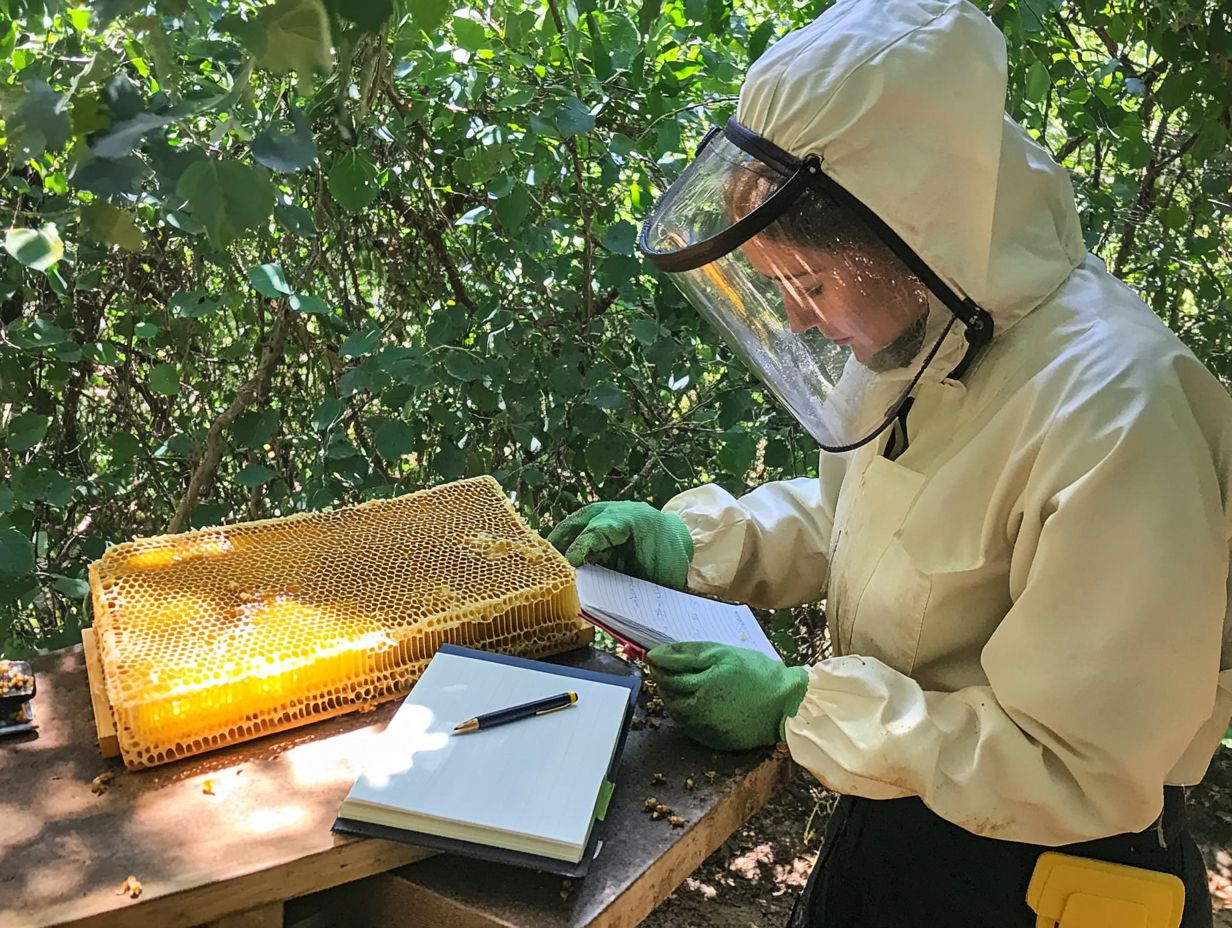
To ensure your goals in hive management are effective, it s essential to make them measurable. This approach allows you to track your progress and assess outcomes with clarity and objectivity. Measurable goals can take the form of quantitative targets, such as the number of honey supers added or the specific reduction in pest populations. These targets provide a clear framework for evaluating your success and aid in performance tracking.
By honing in on these defined metrics, you can easily pinpoint areas that need improvement. Take the time to celebrate your achievements, enhancing your beekeeping practices.
For example, if you set a goal to increase honey production by 20% within a season, you ll want to track the weight of harvested honey on a monthly basis. Monitoring bee health might mean establishing a baseline for colony strength and determining acceptable thresholds for bee losses due to diseases or pests.
You can use journals or digital apps for apiary management to consistently log these important statistics. This practice not only reveals insightful trends but also fosters a deeper understanding of your hive dynamics over time.
3. Set Realistic Goals
Setting realistic goals in hive management is crucial for you, as it ensures your objectives align with the resources at your disposal and your own experience level in beekeeping. Achievable goals not only boost your motivation but also encourage community involvement, allowing you to share both your successes and challenges with fellow beekeepers. Seek mentorship and engage in collaborative learning to boost your beekeeping success!
For example, if you re a novice beekeeper, aiming to successfully harvest honey from one or two hives in your first year is a sensible target. This approach provides a manageable way for you to learn and grow. On the flip side, if you’re trying to manage many hives without prior experience, you’re setting yourself up for frustration, which could jeopardize both the well-being of your bees and your enthusiasm for beekeeping.
By establishing realistic goals, you promote better resource allocation, fostering collaboration within the community. This collaborative spirit can be furthered through team collaboration and organized project management.
This way, you can seek assistance and advice that s tailored to your unique circumstances. Celebrating achievable milestones creates an encouraging environment, making it more likely that you ll sustain your interest and thrive within the vibrant beekeeping community.
4. Set a Deadline
Setting a deadline for your goals in hive management is essential and contributes to a comprehensive beekeeping plan. It provides you with a clear timeline that guides your seasonal management practices and ensures timely honey production. Deadlines fuel your motivation and keep you on track, fostering accountability while allowing you to track your performance more effectively throughout the beekeeping season.
Take, for example, planning for the nectar flow periods. By establishing clear deadlines, you can determine precisely when to introduce additional supers, maximizing your honey yield. This aligns with effective seasonal management and summer management.
Without these timelines, you risk missing optimal windows for hive inspections, which can lead to poor colony management and decreased productivity. Deadlines also emphasize the importance of monitoring bee health and effectively managing pests. Timely interventions can significantly impact overall hive performance.
By sticking to a schedule, you can make informed decisions, adjusting your strategies based on the evolving conditions within your apiaries, ultimately leading to a more successful honey production season.
Monitoring and Adjusting Goals for Hive Management
Monitoring and adjusting your goals for hive management is an ongoing endeavor that allows you to respond to the ever-changing conditions within your apiaries and refine your practices accordingly. This process can benefit from utilizing goal setting and performance tracking tools.
By routinely evaluating the performance of your hives, you can determine whether your existing strategies are effective or if adjustments are necessary to achieve your objectives in your beekeeping plan. This iterative approach cultivates resilience in your beekeeping practices, ultimately ensuring the sustainability and health of your colonies.
1. Regular Hive Inspections
Conducting regular hive inspections is essential for you as a beekeeper to effectively monitor your hive management goals. These inspections empower you to assess the health and strength of your colonies while identifying potential issues before they escalate. By meticulously documenting your observations and outcomes, you create comprehensive records that inform your decision-making and enhance your beekeeping practices, helping you evaluate your progress toward your goals.
These inspections are crucial for understanding your bees and spotting potential problems, such as pests and diseases like Varroa Mite and Small Hive Beetle, as well as American foulbrood. It s important for you to evaluate factors such as brood pattern, honey stores, and overall bee behavior, as these indicators can reveal underlying problems that may jeopardize colony vitality.
Maintaining a detailed log of your inspections complete with dates, findings, and any interventions can significantly enhance your ability to track trends over time. For example, if you notice a pattern of declining brood viability, referencing your past records can help you determine whether this issue is seasonal or a sign of something more serious that demands your immediate attention. Tracking your record-keeping practices helps identify areas for improvement in your apiary management.
2. Tracking Progress
Tracking your progress is crucial for effective hive management, as it empowers you to evaluate your performance against your established goals and make informed, data-driven decisions for improvement.
By regularly reviewing key metrics related to colony health, honey production, and pest management, you enhance the overall effectiveness of your goal-setting efforts and foster a proactive approach to managing your apiary. Utilizing automation technology for hive monitoring can provide real-time insights to aid in your performance tracking.
Utilizing specific indicators such as bee population densities, brood counts, and honey yields allows you to gain a clearer understanding of your colonies’ wellbeing and productivity. Tools like radio frequency identification (RFID) tags or hive monitoring software offer around-the-clock observation of hive conditions, ensuring you can intervene promptly when necessary.
Regular queen-right checks are also essential to ensure the colony has a healthy and productive queen.
Implementing routine inspections and maintaining accurate records empowers you to identify trends over time, such as seasonal fluctuations in production or increases in pest activity.
Ensuring that your hive manipulation techniques are well-documented can also assist in tracking the effectiveness of your interventions.
Ultimately, these methods facilitate better hive management while aligning your beekeeping practices with broader sustainability goals, contributing positively to the health of pollinator populations as a whole. This aligns well with sustainable beekeeping practices that support agricultural sustainability and biodiversity.
3. Making Adjustments as Needed
Adapt quickly to ensure your hive thrives! Making adjustments as needed is essential for effective hive management, enabling you to respond to unforeseen challenges and shifts in your apiary conditions.
Whether you re tweaking pest control strategies or refining your hive management practices, being adaptable ensures that your goals remain relevant and achievable. Encourage community involvement in problem-solving during local beekeeping events. Engaging in mentorship in beekeeping can also provide valuable insights and innovative beekeeping techniques to overcome challenges.
For example, if unexpected weather patterns arise, you might need to reassess your foraging strategies or implement insulation techniques to safeguard your colonies. When confronted with a sudden spike in honeybee diseases, promptly revising medication protocols can mean the difference between a flourishing hive and a failing one.
Incorporating organic practices in your medication protocols can also contribute to long-term bee health management.
In these scenarios, fostering communication with fellow beekeepers can lead to collaborative solutions, such as sharing innovative practices gleaned from various experiences. Understanding that flexibility is crucial allows you to navigate the complexities of hive management more effectively and secure sustainable success.
Involving your team in these discussions can enhance team collaboration and project management in your apiary.
Frequently Asked Questions

What are the benefits of setting hive management goals?
Setting goals for hive management helps beekeepers prioritize tasks, track progress, and ensure the health and productivity of their hives. It also allows for better decision-making and can lead to increased efficiency and profitability.
Goal setting forms a core part of any holistic approach to beekeeping management, aligning with your overall objectives for the apiary and guiding you on how to make hive management decisions.
How do I determine the right goals for my hive management and Apiary Action Plan?
The first step is to assess the current state of your hives and identify areas for improvement. Consider factors such as honey production, pest and disease control, and overall hive health.
Based on this, you can set specific and achievable goals that align with your overall objectives. Utilizing beekeeping supplies appropriately and ensuring your apiary infrastructure supports your goals can significantly enhance your outcomes.
Start setting your goals today for a thriving apiary!
How many goals should I set for my hive management and Apiary Action Plan?
It is recommended to set a maximum of 3-5 goals at a time to avoid overwhelming yourself and your hives. Focus on the most critical areas that need improvement. Make sure your goals are measurable and specific.
Regularly measuring your goals and reviewing them is crucial for timely adjustments and success.
Should I involve my team or other beekeepers in setting goals for hive management and Apiary Action Plan?
Collaboration can be beneficial in setting goals for hive management. Seek input from your team and other experienced beekeepers for different perspectives and ideas.
This involvement can create a sense of ownership and accountability for achieving the goals while enriching your goal-setting process.
How often should I review and adjust my goals for hive management and Apiary Action Plan?
Regularly check your goals don t wait too long to make important adjustments! Depending on the specific goals, review them monthly, quarterly, or annually.
Adjustments may be necessary due to unexpected changes in hive conditions. Using technology to automatically track your progress can streamline this process.
What should I do if I am not meeting my goals for hive management and Apiary Action Plan?
If you’re falling short on your goals, don’t worry let’s figure it out together! Take a step back and reassess the factors that may be hindering your progress.
Make necessary adjustments and seek advice from other beekeepers if needed. Remember to stay motivated and focused on the long-term benefits of achieving your goals.

